The Volgograd Region in the Russian Federation has been named one of the most desertified territories in Russia. In just a few years, West Africa, South Asia, and the Midwest of the United States will become dangerous to human life due to climate change. Having analyzed data on climate change and abnormal heat waves on Earth, scientists have modeled temperature fluctuations for the coming years and have come to disappointing conclusions for certain regions of the planet.
The Volgograd Region in the Russian Federation has been named one of the most desertified territories in Russia. This is the conclusion reached by the leadership of the United Nations Convention to Combat Desertification (UNCCD). According to experts, the region is threatened by drought, crop failure and regular sandstorms. Moreover, today 80% of Volgograd lands have already been degraded.
The world is experiencing worsening land degradation, droughts and other extreme weather events associated with climate change. The concept of “desertification” in the UNCCD means land degradation in arid, semi-arid and dry sub-humid areas as a result of various factors, including climate change and human activities. Volgograd Oblast, which is part of the arid regions of the European part of Russia, also falls under this definition.
The consequences of desertification can be the most tragic. From eternal droughts and inadequate temperature fluctuations to dust storms and massive crop failure. It is obvious that human life in such conditions will become extremely difficult. At the same time, the blame for climate degradation does not lie with ephemeral “natural” processes. The main provocateur of desertification was and remains man.
Contrary to popular belief, desertification is not the natural expansion of existing deserts, but the gradual degradation of land due to overexploitation and grazing, deforestation, inefficient irrigation, etc. In this regard, sustainable land management is the answer to combating land degradation and desertification. There are proven practices and methods that allow achieving positive results in this area. A striking example is the accumulated experience of the Federal Scientific Center for Agroecology, Integrated Land Reclamation and Protective Afforestation of the Russian Academy of Sciences in Volgograd.
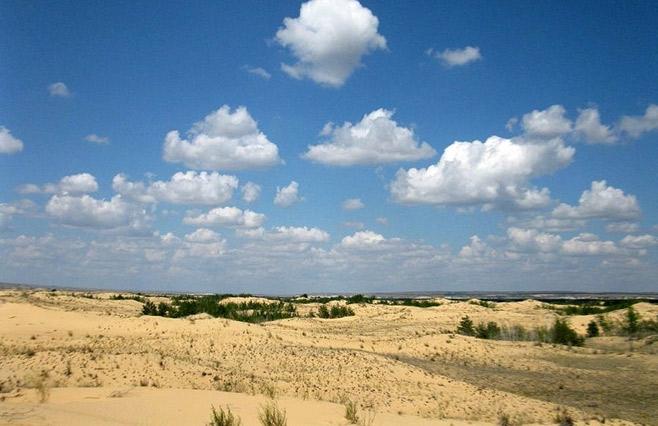
Archedinsko-Don sands of the Volgograd region
The latest data show that, unfortunately, humanity is lagging far behind in fulfilling its global commitments to restore 1 billion hectares of degraded land by 2030. This requires high-level discussion of the data, specific decisions, significant financial investments, and the involvement of all sectors of society. Today, the area of degraded land of varying degrees in the Volgograd Region has reached 80%. There are many reasons for this process. Among them are both natural and anthropogenic. The following types of degradation are distinguished: technological, water erosion, deflation (the process of blowing light sandy and sandy loam soils by the wind), salinization and waterlogging of soils. For example, technological degradation manifests itself in the form of land disturbance, physical degradation, and agro-depletion. The main factor in desertification is the imperfection of agricultural technologies, uncontrolled grazing, and improper irrigation of lands.
As reported by the online publication “V1.ru”, one of the most obvious consequences of desertification that we can observe are regular dust storms. In recent years, their number has increased significantly in the Volgograd region. Dust storms now occur annually, large masses of dust are carried from bare territories over long distances. They reach the borders with Ukraine. Storms come from Kalmykia and Kazakhstan, and forest plantations can protect against them. Rural areas suffer the most from dust storms. Such phenomena lead to crop failure and subsequent increases in market prices. It is necessary to constantly engage in protective afforestation. Many forest belts have already disintegrated and need repair. Foresters and landowners need to be tasked with this. Otherwise, we will ultimately lose the lands themselves. Fortunately, people have now realized the existence of such a problem as desertification.
In just a few years, West Africa, South Asia and the US Midwest will become dangerous for human life due to climate change, CNN reports, publishing the results of research by scientists from the American Purdue University.
After analyzing data on climate change and abnormal heat waves on Earth, scientists modeled temperature fluctuations for the coming years and came to disappointing conclusions for certain regions of the planet. West Africa and some regions of South Asia are among the most vulnerable, since these are areas with a high population density and limited cooling capabilities; in their opinion, abnormally humid heat will settle in the US Midwest.
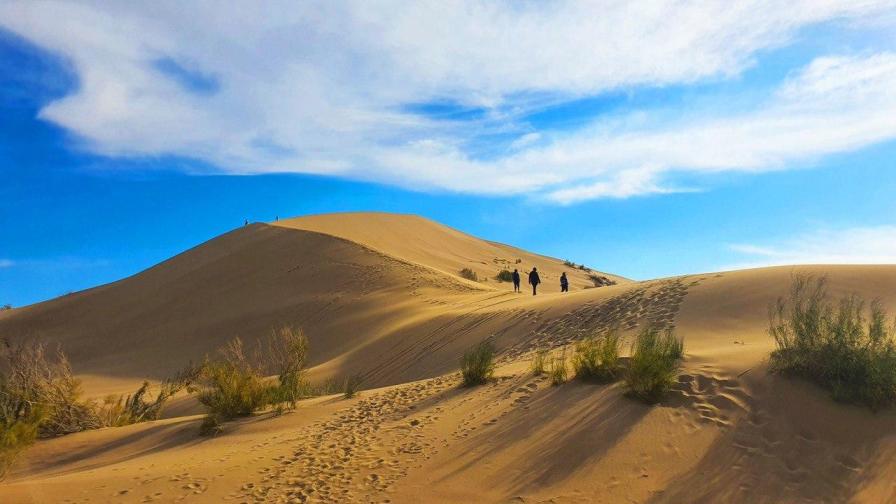
Turanian deserts
According to scientists, the combination of heat and high humidity will have a negative impact on such vital organs as the cardiovascular system and brain, which will significantly increase the mortality rate in the above regions. Currently, according to official WHO data, about 489 thousand people die every year due to heat.
According to Mikhail Lokoshchenko, a leading researcher at the Department of Meteorology and Climatology of the Geography Faculty of Moscow State University, climate warming in the tropics is occurring extremely slowly, so West Africa and South Asia will remain habitable in the near future.
“It is unlikely that entire regions of the Earth will become uninhabitable in the near future. The fact is that warming is happening extremely slowly in the tropics. Warming is most pronounced in high and middle latitudes. In the tropics, near the equator, warming is extremely weak, so we need to study the climate and its changes, but soberly and calmly assess the situation, without unnecessary panic and hysteria,” Lokoshchenko said.
Utah’s drying Great Salt Lake is becoming a significant source of global greenhouse gas emissions that are warming the world, according to a new study, scientists say.
The Great Salt Lake’s volume has shrunk by nearly half in recent years, largely due to water withdrawals by farmers and Utah’s booming population.
Scientists spent seven months in 2020 collecting samples of emissions from the dry salt lake bed. The Royal Ontario Museum in Canada published the study Thursday in the journal One Earth .
“The human-caused drying of the Great Salt Lake is exposing huge areas of the lake bed and releasing huge amounts of greenhouse gases into the atmosphere,” said Soren Brothers, the museum’s climate change curator who led the study.
“The importance of lake drying as a climate change driver needs to be further explored and factored into climate change mitigation and watershed planning,” Brothers added.
The researchers found that the drying lake bed was releasing 4.1 million tons of carbon dioxide and other greenhouse gases into the atmosphere, a 7% increase in Utah’s human-caused emissions. The scientists estimate that 4 million tons of CO2 is roughly equivalent to the combined annual emissions of 140 commercial airplanes.
The Great Salt Lake is the largest salt lake remaining in the Western Hemisphere. The study was conducted during one of the West’s most infamous megadroughts, which at the time of the study had lasted two decades.
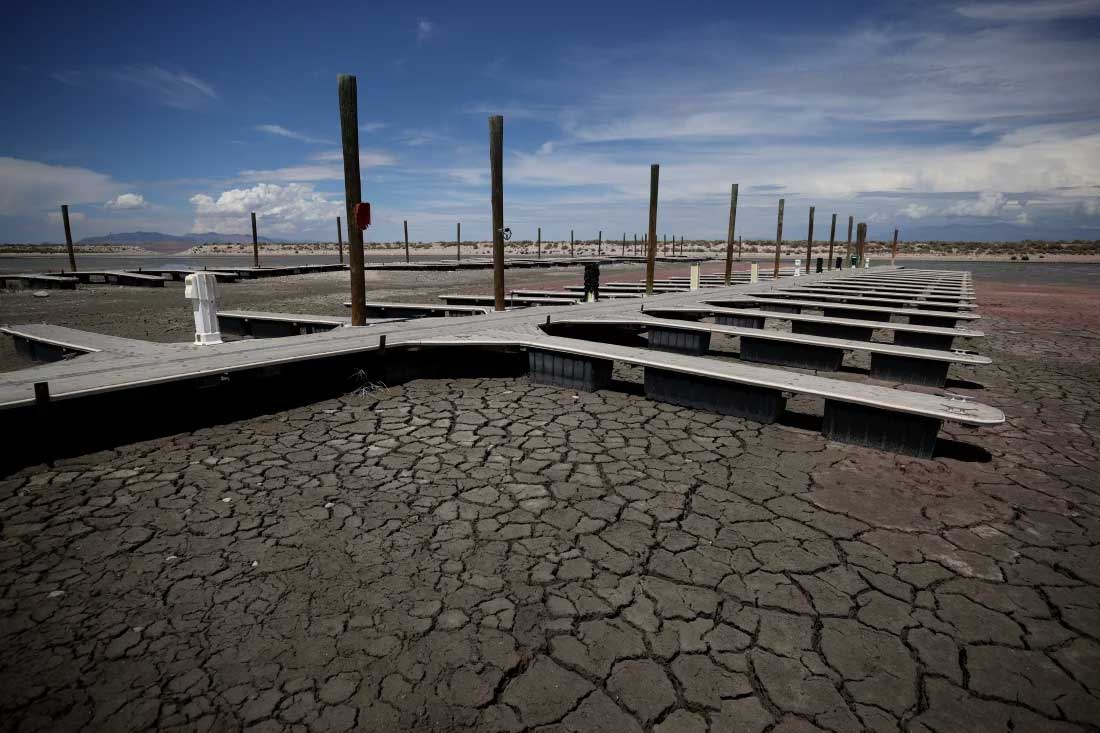
Boat docks sit on dry, cracked ground at Antelope Island Marina on the Great Salt Lake in 2021 near Syracuse, Utah. Justin Sullivan
Scientists say the West is driest in 1,200 years, a long drought made worse by climate change.
Agriculture has also played a huge role in the lake’s decline. Diversion of water upstream to expand alfalfa and dairy farms has reduced the flow of water into the lake. Utah’s rapid population growth has also contributed to this.
The loss of water has serious consequences for animal and human life. Researchers in Utah have begun to note a sharp decline in shorebird populations, such as burrowing owls and snowy plovers, as a result of the brine shrimp die-off.
Dust storms and air pollution caused by the dry lake bed are also a major concern for Utahns. Scientists have also warned that the lake contains high levels of neurotoxins and cancer-causing carcinogens, including arsenic and mercury.
The Great Salt Lake’s level has risen slightly in recent years due to the last two snowy winters. While it is still falling, some believe the recent wetness has given Utah time to reverse its decline.
Utah Governor Spencer Cox has promised to keep the lake from drying up during his administration.
“For generations, the lake was viewed as something dead that just happened to be there and would be there forever,” Cox told NPR in April. “And now that people are realizing that there’s a possibility that it might not always be there, it’s gotten people’s attention in a positive way.”
In recent years, the state legislature has invested nearly $1 billion in water conservation programs, most of which target farmers.
Africa is bearing an increasing burden of climate change and a disproportionately high cost of adapting to key climate conditions, according to a new report from the World Meteorological Organization (WMO).
On average, African countries lose 2-5% of their gross domestic product (GDP), and many lose up to 9% of their budgets to combat climate extremes. In sub-Saharan Africa, adaptation costs are estimated to be between US$30 billion and US$50 billion annually over the next decade, or 2-3% of the region’s gross domestic product, according to the WMO’s State of the Climate in Africa 2023 report.
WMO estimates that by 2030, up to 118 million extremely poor people in Africa, living on less than US$1.90 a day, will be exposed to drought, flooding and extreme heat unless adequate responses are taken. This will put additional strain on poverty reduction efforts and significantly slow economic growth, according to figures cited in the report.
African countries need to prioritize increased investment in national meteorological and hydrological services and accelerate the implementation of the Early Warning for All initiative to save lives and livelihoods. This will help reduce risks, build adaptive capacity, increase resilience at local, national and regional levels, and support sustainable development strategies, the report says.
The report also focuses on the indicators and impacts of climate change in 2023, the hottest year on record for the world. It complements WMO’s State of the Global Climate and is one of a series of WMO regional reports that provide an observational basis to drive action and support decision-making.
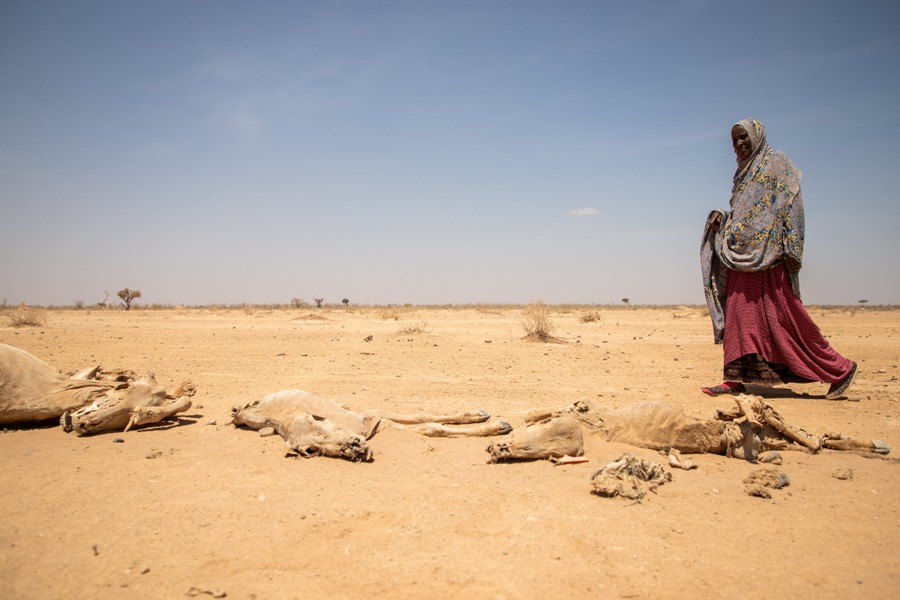
According to WMO Secretary-General Celeste Saulo, Africa has experienced a warming trend over the past 60 years, at a faster rate than the global average. In 2023, the continent experienced deadly heat waves, torrential rains, floods, tropical cyclones and prolonged droughts. While many countries in the Horn of Africa, Southern and Northwest Africa continued to suffer from exceptional multi-year drought in 2023, other countries experienced extreme rainfall, leading to flooding with significant loss of life. These extreme events have had devastating effects on communities, with severe economic impacts. This pattern of extreme weather events has continued in 2024, with parts of Southern Africa experiencing devastating drought. Exceptional seasonal rainfall has caused deaths and destruction in countries in East Africa, including Sudan and South Sudan. This exacerbates the already acute humanitarian crisis on the continent.
Africa faces disproportionate burdens and risks from weather events and climate change-related patterns that trigger massive humanitarian crises with detrimental impacts on agriculture and food security, education, energy, infrastructure, peace and security, public health, water resources and overall socio-economic development.
Samum is the consequence of desertification for the entire planet. In Arab countries, samum is the name given to the wind that comes from the desert, bringing with it “clouds of sand” that obscure the sky and the sun. The dry, hot wind is a strong but short-term squall lasting from 20–30 minutes to 3–5 hours, less often a day. Its main feature is a scorching temperature and a cloud of red dust: during the hours of its arrival, the air temperature rises to 50° and above, and the humidity drops to 10%. Samum is observed in the deserts of North Africa and the Arabian Peninsula and most often has a western and southwestern direction. It mainly occurs in spring and summer.
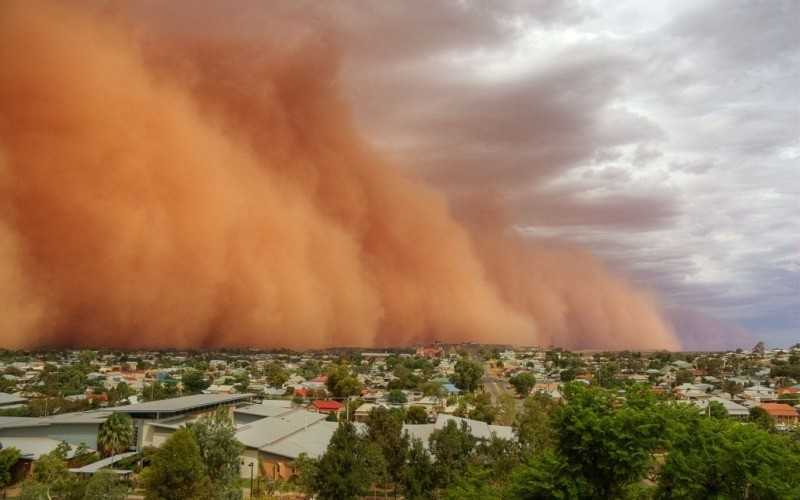
In Arabic, “samum” means “poisonous”. The first known description of the dangerous wind belongs to Herodotus (“red wind”), another popular epithet is “sea of blood”. And these names justify the nature of the samum. Dust clogs the respiratory tract of a person caught in a storm, so that the air seems poisoned and there is nothing to breathe. In addition, before the arrival of the wind, the atmospheric pressure drops sharply to critical values. A sharp jump in temperature and low pressure in inexperienced tourists can lead to heat stroke and fainting.
It should be noted that about 2,000 million tons of dust enter the atmosphere every year, darkening the sky and worsening air quality in regions thousands of kilometers away, and also affecting the economy, ecosystems, weather and climate. Much of this is a natural process, but much of it is the result of poor water and land management.




